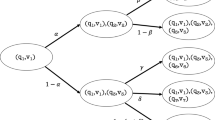Abstract
The mechanistic view of computation contends that computational explanations are mechanistic explanations. Mechanists, however, disagree about the precise role that the environment – or the so-called “contextual level” – plays for computational (mechanistic) explanations. We advance here two claims: (i) Contextual factors essentially determine the computational identity of a computing system (computational externalism); this means that specifying the “intrinsic” mechanism is not sufficient to fix the computational identity of the system. (ii) It is not necessary to specify the causal-mechanistic interaction between the system and its context in order to offer a complete and adequate computational explanation. While the first claim has been discussed before, the second has been practically ignored. After supporting these claims, we discuss the implications of our contextualist view for the mechanistic view of computational explanation. Our aim is to show that some versions of the mechanistic view are consistent with the contextualist view, whilst others are not.



Similar content being viewed by others
Notes
Coelho Mollo (2019), however, also considers individuating computation by appeal to teleological functions.
Piccinini claims that “[i]n order to know which of the computations that are implemented by a computing mechanism is explanatory in a context, we need to know the relevant relations between computations and contexts. Therefore, we cannot determine which computation is explanatory within a context without looking outside the mechanism. (…) Computations have effects on, and are affected by, their context.” (2008, 231). See also Bechtel (2009) who argues that mechanistic explanations, in general, should look around, and Miłkowski (2017) who contends that environmental factors often constrain the functions that the mechanism computes.
We note, however, that Kaplan might be an internalist about computation as he also writes that “[c]omputational models must describe the real structure of the computational mechanisms underlying the input–output mapping in order to explain.” (368). If the mechanisms underlying the input-output mapping are all internal, then there is no need to appeal to contextual factors at all.
References
Bechtel, W. (2009). Looking down, around, and up: Mechanistic explanation in psychology. Philosophical Psychology, 22(5), 543–564.
Bechtel, W., & Shagrir, O. (2015). The non-redundant contributions of Marr’s three levels of analysis for explaining information-processing mechanisms. Topics in Cognitive Science, 7, 312–322.
Block, N. (1990). Can the mind change the world? In G. Boolos (Ed.), Meaning and method: Essays in honor of Hilary Putnam (pp. 137–170). Cambridge: Cambridge University Press.
Chalmers, D. J. (1994). On implementing a computation. Minds and Machines, 4(4), 391–402.
Coelho Mollo, D. (2018). Functional individuation, mechanistic implementation: The proper way of seeing the mechanistic view of concrete computation. Synthese, 195, 3477–3497.
Coelho Mollo, D. (2019). Are there teleological functions to compute? Philosophy of Science. https://doi.org/10.1086/703554, forthcoming.
Craver, C., & Kaplan, D. M. (2018). Are more details better? On the norms of completeness for mechanistic explanations. The British Journal for the Philosophy of Science, axy015, https://doi.org/10.1093/bjps/axy015.
Dewhurst, J. (2018a). Individuation without representation. The British Journal for the Philosophy of Science, 69(1), 103–116.
Dewhurst, J. (2018b). Computing mechanisms without proper functions. Minds and Machines, 28(3), 569–588.
Egan, F. (2017). Function-theoretic explanation and neural mechanisms. In D. M. Kaplan (Ed.), Explanation and integration in mind and brain science (pp. 145–163). Oxford University Press.
Hopcroft, J. E., Motwani, R., & Ullmann, J. D. (2000). Introduction to automata theory, languages, and computation. Pearson Education.
Kaplan, D., & Craver, C. (2011). The explanatory force of dynamical and mathematical models in neuroscience: A mechanistic perspective. Philosophy of Science, 78, 601–627.
Marr, D. (1982). Vision. A computational investigation into the human representation and processing of visual information. Freeman Press.
Marr, D., & Hildreth, E. (1980). Theory of edge detection. Proceedings of the Royal Society of London. Series B. Biological Sciences, 207(1167), 187–217
Miłkowski, M. (2013). Explaining the computational mind. MIT Press.
Miłkowski, M. (2017). The false dichotomy between causal realization and semantic computation. Hybris. Internetowy Magazyn Filozoficzny, 38, 1–21.
Piccinini, G. (2006). Computational explanation in neuroscience. Synthese, 153(3), 343–353.
Piccinini, G. (2008). Computation without representation. Philosophical Studies, 137(2), 205–241.
Piccinini, G. (2015). Physical computation: A mechanistic account. Oxford University Press.
Piccinini, G. (2017). Computation in Physical Systems, in Edward N. Zalta (editor). The Stanford Encyclopedia of Philosophy.https://plato.stanford.edu/archives/sum2017/entries/computation-physicalsystems/. Accessed 21 June 2019.
Rusanen, A., & Lappi, O. (2016). On computational explanations. Synthese, 193, 3931–3949.
Schweizer, P. (2016). In what sense does the brain compute? In V. C. Müller (Ed.), Computing and philosophy. Heidelberg: Springer (Synthese Library.
Shagrir, O. (2001). Content, computation and externalism. Mind, 110(438), 369–400.
Shagrir, O. (2010). Marr on computational-level theories. Philosophy of Science, 77, 477–500.
Shagrir, O. (2019). In defense of the semantic view of computation. Synthese, forthcoming.
Shagrir, O., & Bechtel, W. (2017). Marr’s computational level and delineating phenomena. In D. M. Kaplan (Ed.), Explanation and integration in mind and brain science (pp. 190–214). Oxford University Press.
Sprevak, M. (2010). Computation, individuation, and the received view on representation. Studies in History and Philosophy of Science Part A, 41(3), 260–270.
Sprevak, M. (2018). Triviality arguments about computational implementation. In M. Sprevak & M. Colombo (Eds.), Routledge Handbook of the Computational Mind (pp. 175–191). London: Routledge.
Acknowledgements
This work has been supported by the German-Israeli Foundation for Scientific Research and Development (G-1257-116.4/2014; recipients: Jens Harbecke, Vera Hoffmann-Kolss, and Oron Shagrir). We would like to thank Dimitri Coelho Mollo, Joseph Dewhurst, Lotem Elber-Dorozko, Ori Hacohen, Shahar Hechtlinger, Vera Hoffmann-Kolss, David Kaplan, Jan Philipp Köster, Arnon Levy, Gualtiero Piccinini, Bill Bechtel and Carlos Zednik for valuable feedback on our paper during several meetings during the course of the GIF project 'Causation and Computation in Cognitive Neuroscience'. We would also like to thank Zehava Cohen for her help in developing the illustrations.
Author information
Authors and Affiliations
Corresponding author
Additional information
Publisher’s note
Springer Nature remains neutral with regard to jurisdictional claims in published maps and institutional affiliations.
Rights and permissions
About this article
Cite this article
Harbecke, J., Shagrir, O. The role of the environment in computational explanations. Euro Jnl Phil Sci 9, 37 (2019). https://doi.org/10.1007/s13194-019-0263-7
Received:
Accepted:
Published:
DOI: https://doi.org/10.1007/s13194-019-0263-7




